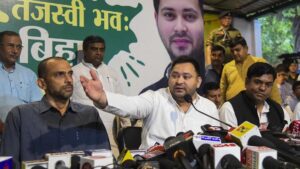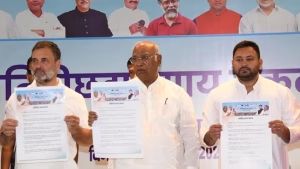Bihar – The Opposition Grand Alliance in Bihar has unveiled an ambitious political strategy centered around a groundbreaking Bihar deputy CM formula that proposes three deputy chief ministers representing diverse communities. This innovative approach aims to ensure inclusive governance if the alliance secures victory in the upcoming assembly elections.
Senior leaders from the Rashtriya Janata Dal and Congress confirmed on Wednesday that the coalition is finalizing its seat-sharing arrangement while simultaneously planning to appoint deputy chief ministers from Dalit, Muslim, and extremely backward classes communities. This strategic move represents a significant shift in Bihar’s political landscape.
Tejashwi Yadav as Chief Ministerial Face

Rashtriya Janata Dal leader Tejashwi Yadav has emerged as the Grand Alliance’s de-facto chief ministerial candidate, though formal endorsement from all alliance partners remains pending. The Bihar deputy CM formula positions Tejashwi, who hails from a backward community and has previously served as deputy CM twice, to lead a more representative government structure.
Tejashwi will compete against incumbent Chief Minister Nitish Kumar of the National Democratic Alliance, which currently operates with two deputy chief ministers: Samrat Chaudhary from the OBC community and Vijay Kumar Sinha from the Bhumihar community.
Seat-Sharing Agreement Details

RJD spokesperson Mrityunjay Tiwari revealed that the coalition’s seat-sharing formula is nearly finalized, with the RJD expected to contest approximately 125 seats—19 fewer than the 143 seats it contested in 2020. Congress will field candidates in 50-55 constituencies, while Left parties will contest around 25 seats.
The remaining constituencies will be distributed among smaller alliance partners, including the Vikassheel Insaan Party, Lok Janshakti Party led by Pashupati Kumar Paras, and Jharkhand Mukti Morcha. This careful distribution accompanies the proposed Bihar deputy CM formula to ensure balanced representation.
Political Significance and Strategy

Tiwari emphasized that the Bihar deputy CM formula clearly indicates Tejashwi Yadav’s emergence as the coalition’s undisputed chief ministerial face. He described it as a masterstroke aimed at rebranding the RJD’s legacy, moving beyond perceptions of Yadav-centric politics toward a more layered and inclusive approach.
The formula seeks to bring Dalits, extremely backward classes, and minorities into visible positions of power, addressing historical concerns about narrow community-based governance. This strategic repositioning responds to challenges the Grand Alliance faced in previous elections.
Congress Leadership’s Vision

Congress spokesperson Praveen Singh Kushwaha stated that the proposed Bihar deputy CM formula reflects Rahul Gandhi’s effort to balance dominance with inclusivity. He characterized the decision as symbolic, representing an attempt to reclaim the social justice narrative in a more pluralistic form that resonates across multiple communities.
Also Read: NDA Seat Sharing Announcement Sparks Intense Talks Ahead of Bihar Polls
This approach aligns with broader Congress strategies of coalition-building and ensuring representation for marginalized communities in governance structures.
VIP’s Perspective and Expectations
Vikassheel Insaan Party spokesperson Dev Jyoti praised the Bihar deputy CM formula as reflecting Tejashwi Yadav’s farsightedness. He predicted that by Thursday evening, Tejashwi would be formally declared as the alliance’s chief ministerial candidate, with VIP leader Mukesh Sahni potentially serving as one of the deputy chief ministers.
This expectation demonstrates how the formula serves to accommodate diverse alliance partners while maintaining cohesion within the Grand Alliance structure.
Opposition Criticism and Skepticism
Critics have questioned the viability of the Bihar deputy CM formula, with Ram Pukar Sharma of the Rashtriya Lok Morcha dismissing alliance leaders as specialists in building “air castles.” He suggested the alliance wouldn’t reach triple-digit seat numbers and sarcastically recommended they declare their entire council of ministers.
Anil Kumar Singh of the Jan Suraaj Party called the plan a “fake message” and practically impossible, arguing that reaching the magical number of 123 seats for majority would be difficult. He warned that power-sharing of this scale could trigger bureaucratic overlap and internal rivalry while potentially diluting Tejashwi’s authority.
Historical Context of Deputy CMs in Bihar
Bihar has appointed ten deputy chief ministers throughout its political history. Anugrah Narayan Sinha of Congress served the longest tenure at 11 years and 94 days alongside Sri Krishna Sinha, establishing early templates of co-governance. Notable figures like Karpoori Thakur served 329 days before ascending to the chief minister position.
The BJP’s Sushil Kumar Modi held the second-longest deputy CM tenure in the country at 10 years and 316 days. Tejashwi Yadav himself served just over three years across two stints in Grand Alliance governments between 2015 and 2025.
The current NDA government’s deputy chief ministers, Samrat Choudhary and Vijay Sinha, have served approximately 252 days each since January 28, 2024.
Political Analysis and Implications
Political analyst Dhirendra Kumar explained that the deputy CM position serves as both a political olive branch and a balancing mechanism. For Bihar deputy CM formula, the Bihar deputy CM formula offers multiple advantages: it counters accusations of dynastic dominance, signals departure from the Yadav-centric axis, and provides visible representation to Dalit, EBC, and Muslim communities.
This strategic positioning could prove crucial in attracting broader voter support across Bihar’s diverse social landscape, potentially determining the Grand Alliance’s electoral fortunes in the upcoming assembly elections.

